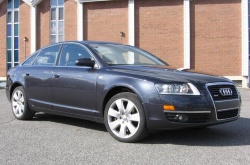 2007 Audi A6 4.2; photo by Chris Chase. Click image to enlarge |
|
More Audi A6 reviews on Autos.ca
Manufacturer’s web site |
Review and photos by Chris Chase
The 2005 Audi A6 is the third generation of this mid-sized luxury car, but if you want to get technical, it’s the sixth generation of a car that began its life as the Audi 100 in 1968.
It was the 1997 design that made the A6 beautiful for the first time, and the 2005 redraw combined an evolution of those good looks with an air of athleticism that has been carried forward to the Audis of today.
All 2005 A6s used a six-speed automatic transmission and Audi’s Quattro all-wheel drive system, leaving most differences down to engine choice and, in 2006, body style, with the addition of a station wagon, or Avant, variant.
The third-generation A6 arrived with a choice of two engines: a 3.2-litre V6 (255 hp/243 lb.-ft.), and a 4.2-litre V8 (335 hp/310 lb.-ft.) that first appeared in the high-performance S4 but was tuned differently for the A6. The V6 was the first Audi engine to use the company’s FSI direct fuel injection system.
A station wagon (called the Avant) was added for 2006, and was fitted exclusively with the 3.2-litre.
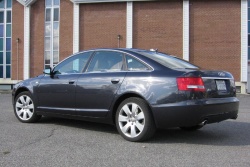 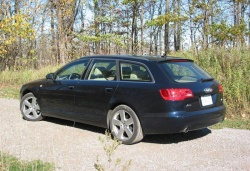 2007 Audi S6. Middle photo by Peter Bleakney. Click image to enlarge |
For 2007, Audi added the S6, a performance variant powered by the same V10 engine (435 hp/398 lb.-ft.) as the bigger S8. Also that year, the V8 got the FSI direct fuel injection system, boosting output to 350 hp and 325 lb.-ft. of torque.
The 2008 A6 got a raft of updates to its lists of standard and optional features, but the mechanicals were carried over from 2007.
2009 brought refreshed styling – including the A6’s first use of Audi’s LED running lights (now a design staple across the industry) – and perhaps more importantly, the addition of a new 3.0-litre, supercharged V6 making 310 hp and 300 lb.-ft. of torque used in all-wheel drive sedan and wagon models. This relegated the 3.2-litre to a new base model with front-wheel drive and a continuously variable transmission.
In 2010, the 3.2-litre engine got an extra 10 horsepower, and was discontinued in 2011, along with the front-wheel drive model.
Fuel consumption estimates for the 3.2-litre Quattro model were 12.1 L/100 km (city) and 8.0 (highway) for the 3.2-litre V6, while the later front-drive version did better, at 11.4/ 7.4 L/100 km.
The 3.0-litre supercharged V6 Quattro model was rated at 12.0/8.0 L/100 km
With the V8, fuel consumption ratings were 13.1/8.8 L/100 km, and the S6’s V10 was rated 15.2/10.4 L/100 km.
Consumer Reports has reliability data for V6-powered models only; they give the car an average to below-average reliability rating.
This thread at AudiZine.com is a compilation of a number of posts at the site on the topic of carbon build-up in Audi’s FSI engines. Meanwhile, this thread has ugly photos of carbon buildup in various Audi and Volkswagen TSI motors.
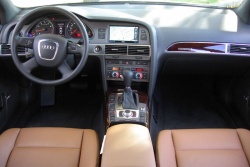 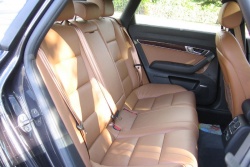 2007 Audi A6 4.2; photos by Chris Chase. Click image to enlarge |
The A6’s LED taillight assemblies are source of trouble, triggering intermittent faults warning that a rear taillight and/or turn signal isn’t working.
Failed trunk latches are common. The symptoms are either a trunk that won’t stay shut, or does close, but triggers a “trunk open” warning from the car’s electronics. Lubricating the latch is a short-term fix, but you’ll probably need to replace it eventually.
Air conditioning that won’t blow cold could be caused by a bad connection between a temperature/pressure sensor in the A/C system and the car’s on-board computer.
Here’s a thread at AudiWorld.com about A6s that stall or run rough, along with the appearance of a number of warning lights indicating a fault with the engine’s electronic controls.
A6 owners who have shared their reliability experiences at TrueDelta.com mentioned problems with power steering leaks, power window failures, Bluetooth, as well as a couple mentions of bad fuel pumps. A fuel gauge that reads empty even when there is gas in the tank is commonly caused by a bad wiring connection between the fuel level sending unit and the instrument cluster.
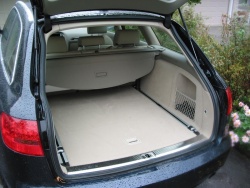 2007 Audi A6 Avant; photo by Peter Bleakney. Click image to enlarge |
Beyond the above-noted items, the A6 is also known for problems with many of its electrical accessories and systems.
In crash tests, the Insurance Institute for Highway Safety (IIHS) found little to fault, save for a likelihood of upper leg injury to the driver in its frontal offset impact test. The A6 scores “good” in both that and the side impact test.
The National Highway Traffic Safety Administration (NHTSA) hasn’t crash-tested an A6 since 2002.
Canadian Black Book (CBB) suggests that used A6 values line up pretty closely to those for its competitors from BMW (5 Series) and Mercedes-Benz (E-Class), while comparable cars from Japanese and American makers are less expensive. And, according to CBB, the A6 tends to boast higher resale values, as a percentage of MSRP.
As is the tendency with German sport sedans, the A6 is an appealing car where the driving experience is the priority. The reliability story is the same old song-and-dance: reliability is so-so at best, and replacement parts and repairs are expensive. At least few of the A6’s known problems are serious mechanical flaws, but even that doesn’t fix the fact that too often, a vehicle’s reliability seems inversely proportional to its MSRP. Heed my usual warnings if you do settle on a used A6: have it checked by a trustworthy mechanic before buying, and avoid cars that don’t come with a detailed service history.
|
Pricing
Black Book Pricing (avg. retail) January, 2012:
Online resources
Recalls
2006-2008: On certain Audi A6 Avant and Q7, if one of the automatic rear lid struts has a total loss of pressure, the resultant slow movement of the rear lid is interpreted by the software as an intended manual close, and the motor clutch releases to close the rear lid immediately. This can result in an unintended rapid closing of the rear lid with a risk of personal injury. Correction: Dealers will install updated software.Transport Canada Recall Number: 2008116; Units affected: 3,601 2005: On certain Audi A6 Quattro and Allroad Quattro, aging of the plastic material in the fuel tank rollover valve, combined with bending stress from the aluminum ventilation line to the rollover valve nipple, may lead to cracking of the nipple. If this happens, a fuel leak may result. Fuel leakage in the presence of an ignition source could result in a vehicle fire. Correction: Dealers will reinforce the rollover valve nipple.
Crash test results
Used vehicle prices vary depending on factors such as general condition, odometer reading, usage history and options fitted. Always have a used vehicle checked by an experienced auto technician before you buy. For information on recalls, see Transport Canada’s web-site, www.tc.gc.ca, or the U.S. National Highway Transportation Administration (NHTSA)web-site, www.nhtsa.dot.gov. For information on vehicle service bulletins issued by the manufacturer, visit www.nhtsa.dot.gov. For information on consumer complaints about specific models, see www.lemonaidcars.com. |











